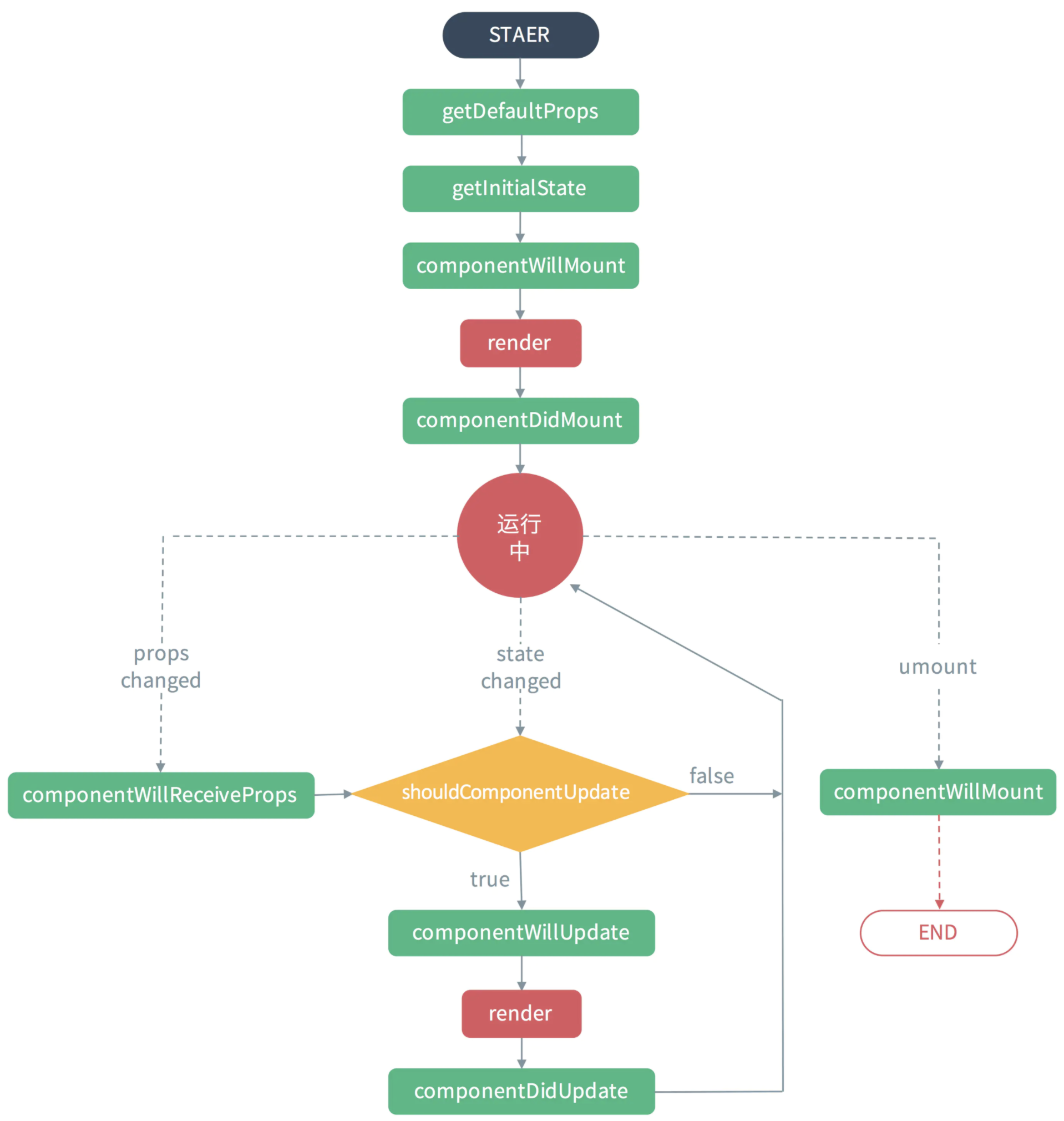[TOC]
react父子组件交互生命周期执行顺序
整理转载自:https://www.jianshu.com/p/318ffc6f4848
1. 组件生命周期执行流程
在网上找到一张生命周期执行顺序图:

1.1 组件挂载的过程
初始化props,通过类的静态属性defaultProps或者getDefaultProps函数,初始化的props会与父组件指定的props合并,最后赋值给this.props
constructor(),或者getInitialState
componentWillMount(),此时dom还没渲染,在这里执行的setState不会导致重绘,执行无效果
render()
componentDidMount(),在这里执行的setState会导致重绘(或称为二次渲染)
1.2 组件被动更新(父组件调动setState)
componentWillReceiveProps(),这时子组件的props仍然是旧的,可以在这里把新的props通过setState设置进state中,不会触发二次渲染
shouldComponentUpdate(),这里读取到的state是以上更新后的state
componentWillUpdate(),不能在这里执行setState,执行了无效果
render()
componentDidUpdate(),可以在这里进行异步的setState
1.3 组件主动更新(当前组件调用setState)
- 执行的函数相比上面的被动更新流程,少了一个componentWillReceiveProps方法,其余的都一样。
1.4 组件卸载
componentWillUnmount(),用于清除定时器、事件绑定;React 官方不建议在 componentWillMount() 修改 state ,通常建议在 componentDidMount(), 如果需要设置 state 的初始状态,可以在 (es6:)constructor() 或者 (es5:)getInitialState() 中设置。
setState是一个异步操作,修改的state必能通过this.state.xxx来马上读取,但可以在setState的第二个参数(回调函数)中读取更新后的值。执行这个函数的时候,新状态会被存放进队列中,稍后才进行状态合并,接着触发shouldComponentUpdate和render,所以连续多次的setState不会影响效率,只会触发一次render
2. 父子组件生命周期执行顺序
2.1 初始化阶段
总结:当执行render子组件的时候,才会进入子组件的生命周期,子组件的周期结束后,再回到上级的周期。
import React from 'react';
import ReactDOM from 'react-dom';
const buildClass = (name)=>{
return class extends React.Component{
constructor(props) {
super(props);
console.log( name + ' constructor');
}
componentWillMount() {
console.log( name + ' componentWillMount');
}
componentDidMount() {
console.log( name + ' componentDidMount');
}
componentWillUnmount() {
console.log( name + ' componentWillUnmount');
}
componentWillReceiveProps(nextProps) {
console.log( name + ' componentWillReceiveProps(nextProps)');
}
shouldComponentUpdate(nextProps, nextState) {
console.log( name + ' shouldComponentUpdate(nextProps, nextState)');
return true;
}
componentWillUpdate(nextProps, nextState) {
console.log( name + ' componentWillUpdate(nextProps, nextState)');
}
componentDidUpdate(prevProps, prevState) {
console.log( name + ' componetDidUpdate(prevProps, prevState)');
}
}
}
class Child extends buildClass('Child'){
render(){
console.log('Child render')
return (<div>child</div>)
}
}
class Parent extends buildClass('Parent'){
render(){
console.log('Parent render')
return (<Child />)
}
}
ReactDOM.render(
<Parent />,
document.getElementById('root')
);
执行结果:
Parent constructor
Parent componentWillMount
Parent render
Child constructor
Child componentWillMount
Child render
Child componentDidMount
Parent componentDidMount
2.2 子组件主动更新
子组件通过setState修改自己的状态。
修改上面的子组件代码:
class Child extends buildClass('Child'){
render(){
console.log('Child render')
return (
<button onClick={()=>{this.setState({data:123})}}>child</button>
)
}
}
执行结果:
Child shouldComponentUpdate(nextProps, nextState)
Child componentWillUpdate(nextProps, nextState)
Child render
Child componetDidUpdate(prevProps, prevState)
2.3 子组件被动更新
父组件通过props把自己的state传递给子组件,父组件执行setState更新状态还原子组件的代码,修改父组件代码如下:
class Parent extends buildClass('Parent'){
render(){
console.log('Parent render')
return (
<div>
<Child />
<button onClick={()=>{this.setState({data:123})}}>Parent</button>
</div>
)
}
执行结果:
Parent shouldComponentUpdate(nextProps, nextState)
Parent componentWillUpdate(nextProps, nextState)
Parent render
Child componentWillReceiveProps(nextProps)
Child shouldComponentUpdate(nextProps, nextState)
Child componentWillUpdate(nextProps, nextState)
Child render
Child componetDidUpdate(prevProps, prevState)
Parent componetDidUpdate(prevProps, prevState)
总结 :不管父组件有没有把数据传递给子组件,只要父组件setState,都会走一遍子组件的更新周期。而且子组件被动更新会比主动更新所执行的流程多出来一个componentWillReceiveProps 方法。
如果在以上被动更新的基础上,修改buildClass中的代码,使 shouldComponentUpdate返回false,代码如下:
shouldComponentUpdate(nextProps, nextState) {
console.log( name + ' shouldComponentUpdate(nextProps, nextState)');
return false;
}
点击parent中的更新按钮,仅仅输出一句:Parent shouldComponentUpdate(nextProps, nextState) 结论:只要组件在以上函数中返回false,则子组件不会进行更新re-render,所有更新流程都不执行了。
